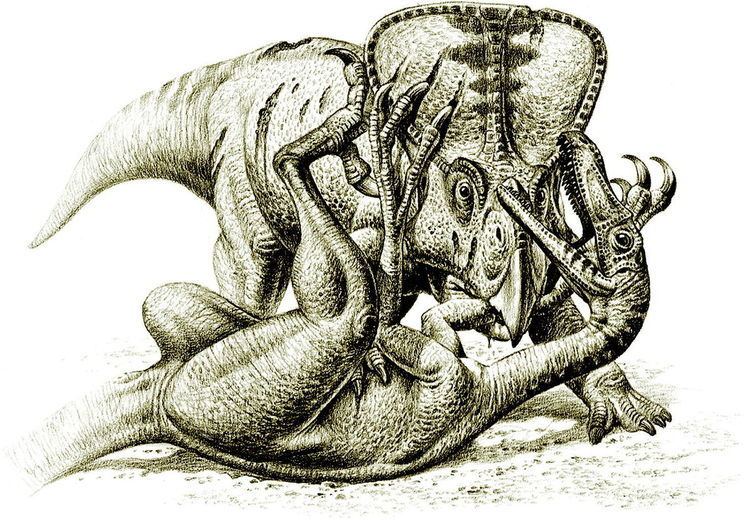 | ||
The "raptors" portrayed in Jurassic Park were actually modeled after the closely related dromaeosaurid Deinonychus. Paleontologists in both the novel and film excavate a skeleton in Montana, far from the central Asian range of Velociraptor but characteristic of the Deinonychus range. A character in Crichton's novel also states that "Deinonychus is now considered one of the velociraptors", which suggests that Crichton used the controversial taxonomy proposed by Gregory S. Paul, even though the "raptors" in the novel are at another point referred to as V. mongoliensis. Crichton met with the discoverer of Deinonychus, John Ostrom, several times at Yale University to discuss details of the animal's possible range of behaviors and appearance. Crichton at one point apologetically told Ostrom that he had decided to use the name Velociraptor in place of Deinonychus because the former name was "more dramatic". According to Ostrom, Crichton stated that the Velociraptor of the novel was based on Deinonychus in almost every detail, and that only the name had been changed. The Jurassic Park filmmakers also requested all of Ostrom's published papers on Deinonychus during production. They portrayed the animals with the size, proportions, and snout shape of Deinonychus rather than Velociraptor.
Production on Jurassic Park began before the discovery of the large dromaeosaurid Utahraptor was made public in 1991, but as Jody Duncan wrote about this discovery: "Later, after we had designed and built the Raptor, there was a discovery of a Raptor skeleton in Utah, which they labeled 'super-slasher'. They had uncovered the largest Velociraptor to date - and it measured five-and-a-half-feet tall, just like ours. So we designed it, we built it, and then they discovered it. That still boggles my mind." Spielberg was particularly pleased with the discovery of the Utahraptor because of the boost it gave to the Velociraptors in his film. Spielberg's name was briefly considered for naming of the new dinosaur. In reality, Velociraptor, like many other maniraptoran theropods, was covered in feathers. Jurassic Park and its sequel The Lost World: Jurassic Park were released before this discovery, so the creatures in both films are depicted as featherless with scales all over in the manner of modern reptiles. For Jurassic Park III, the male Velociraptor was given quill-like structures along the back of the head and neck. While this was the extent to which CGI effects were able to render feathers at the time, the structures do not resemble the down-like feathers real-life dromaeosaurids bore or the fully developed arm feathers, akin to the wing feathers of modern birds, born by Velociraptor. In Jurassic World, the Velociraptors return as protagonists as they have been extensively trained by their new caretaker, Owen Grady, but their design was the same as it was from the first two films, which drew criticism due to their lack of feathers.
Since the release of Crichton's Jurassic Park, Velociraptor and its relatives are encountered in numerous toy lines, animated films, video games, television series and documentaries. In 1995, the city of Toronto named its new NBA expansion team the Raptors.
In the TV series Beast Wars, Dinobot, one of the show's most popular and complex characters- starting out as a villain before defecting for egotistical reasons, gradually becoming a trusted member of the heroes- transformed into a velociraptor as his beast mode.
